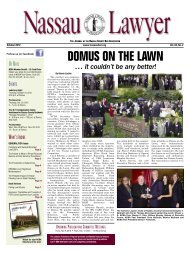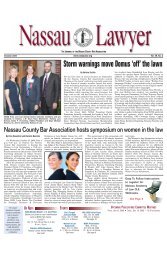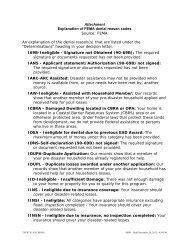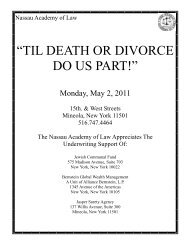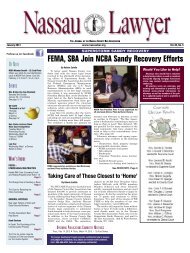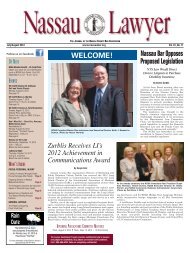302 B.R. 760 Page 18302 B.R. 760(Cite as: 302 B.R. 760)Trading Group, Inc., 835 F.2d 1504 (1st Cir.1987), aFirst Circuit opinion authored by then Circuit JudgeStephen Breyer. Boston Trading involved a transfereewho received payments for the sale <strong>of</strong> a businessknowing that the transferors had obtain the transferredfunds through fraud. See id. at 1506. The courtconcluded that the despite the transferee's knowledge<strong>of</strong> the illegitimate source <strong>of</strong> the funds, his receipt didnot amount to a lack <strong>of</strong> good faith under Massachusetts'fraudulent conveyance statute--identical in allrelevant respects to the D.C.L. See HBE LeasingCorp. v. Frank, 48 F.3d 623, 634 n. 5 (2d Cir.1995)(noting that both the Second Circuit and New Yorkcourts have "encouraged recourse to case law <strong>of</strong> otherjurisdictions[,]" "[i]n order to promote a uniform nationalinterpretation <strong>of</strong> the UFCA."). Judge Breyerexplained that, at least where the transferee did notparticipate in--but only knew about--the originalfraud, the transferee had at most obtained a preference.See id. at 1512. Fraudulent conveyance law wasnot implicated because the fraud did not concern theconveyance itself, but only the "manner in which the... debt" to the defrauded party arose. Id. at 1510.Sharp argues on this appeal, as it did before theBankruptcy Court, that a different result is compelledby the Second Circuit's holding in HBE Leasing, 48F.3d 623. Specifically, Sharp relies on an excerptfrom that decision in which the court concluded thatwhere ... a transferee has given equivalent value inexchange for the debtor's property, the statutory requirement<strong>of</strong> "good faith" is satisfied if the transfereeacted without either actual or constructiveknowledge <strong>of</strong> any fraudulent scheme.Id. at 636. Sharp contends that at the time <strong>of</strong> thetransfer, State Street had actual--or at the very leastconstructive--knowledge <strong>of</strong> the fraudulent schemethrough which Sharp acquired the funds used to retirethe debt to State Street. Indeed, it is alleged to haveknown at the time it gave its consent to the $25 millionnote purchase that the funds were being raisedfraudulently and would be used, in part, to refinanceSharp's debt to State Street, and that any surplusfunds raised would quite likely be looted by theSpitzes. As the Bankruptcy Court properly concluded,however, an examination <strong>of</strong> the facts <strong>of</strong> HBELeasing reveals the inapplicability <strong>of</strong> that case here.*782 In HBE Leasing, judgment creditors sought toset aside mortgages given by the judgment debtor tothe mother <strong>of</strong> the debtor's principal. The mortgageswere given in exchange for a contemporaneous advance<strong>of</strong> cash that constituted equivalent value. However,shortly after the funds advanced in exchange forone <strong>of</strong> the mortgages was received by the debtor, thefunds were disbursed to the debtor's principal, purportedlyin satisfaction <strong>of</strong> loans he had previouslymade to the debtor. When examined in isolation, thatmortgage could not be avoided as constructivelyfraudulent. Even if the mother were regarded as aninsider, the rule that preferential payments to insidersare per se lacking in good faith, see, e.g., FarmStores, Inc. v. School Feeding Corp., 102 A.D.2d249, 477 N.Y.S.2d 374, 378 (1984), aff'd, 64 N.Y.2d1065, 489 N.Y.S.2d 877, 479 N.E.2d 222 (1985), didnot apply, since the mortgages secured a contemporaneousadvance <strong>of</strong> funds--not a pre-existing debt--and thus had no net effect on the debtor's balancesheet. See HBE Leasing, 48 F.3d at 635. Instead, theSecond Circuit applied the good faith element <strong>of</strong> theD.C.L's definition <strong>of</strong> fair consideration to collapse thetwo transactions by which the money given to thedebtor in exchange for the mortgage was immediatelyreconvened for a purpose deemed fraudulent underthe D.C.L., viz. to bestow a preference on an insider.Applying this framework, "the net result was that [themother] received a mortgage from the judgmentdebtor, while [the son] received money from [themother]. Thus at the end <strong>of</strong> the day [the judgmentdebtor] received nothing in exchange for the firstmortgage." Id. at 637. The Second Circuit held thatthe mother's actual or constructive knowledge at thetime she received the mortgages that the considerationshe advanced in exchange would be used for afraudulent purpose was sufficient to show a lack <strong>of</strong>good faith. See id.Furthermore, the Second Circuit explicitly considered(and rejected) an alternative ground advanced bythe parties seeking to avoid the transaction-- namely,that a lack <strong>of</strong> good faith on the part <strong>of</strong> the transferee(i.e., the mother) was grounds for avoiding the mortgage"independent <strong>of</strong> the role that mental states playin the analysis whereby transactions are collapsed."Id. at 636. Based both on the factual scenario involvedin the case and on the Second Circuit's holdingthat a lack <strong>of</strong> good faith was not an independentground for avoiding the mortgage, the BankruptcyCourt reached the following conclusion: the relevance<strong>of</strong> the Second Circuit's assertion that actual orconstructive notice <strong>of</strong> "any fraudulent scheme" isenough to establish the transferee's lack <strong>of</strong> good faithis limited to cases involving "a fraudulent scheme© 2009 Thomson Reuters. No Claim to Orig. US Gov. Works.
302 B.R. 760 Page 19302 B.R. 760(Cite as: 302 B.R. 760)that has the effect <strong>of</strong> depriving the debtor <strong>of</strong> the benefit<strong>of</strong> the consideration given in exchange for thetransfer that is sought to be avoided-- for exampleknowledge that would provide a basis for collapsingtwo transactions under the analysis set forth in HBELeasing." Bankr.Dec. at 520. Further undercuttingSharp's assertion that HBE Leasing renders a transferconstructively fraudulent when the transferee knowsthat the funds transferred were fraudulently acquiredis the fact that the Second Circuit cited with approvalJudge Breyer's decision in Boston Trading--a decisionthat, as discussed above, reached precisely theopposite result. See HBE Leasing, 48 F.3d at 636.The transaction at issue in HBE Leasing involved acontemporaneous exchange between a transferor andtransferee--not the repayment <strong>of</strong> a pre-existing debt.The knowledge to which the Second Circuit referredwas the transferee's actual or constructive awarenessat the time it advanced the consideration that thetransferor would not, in fact, either retain those fundsor expend them for some legitimate *783 corporatepurpose. The intent <strong>of</strong> the holding was to avoid afacially legitimate transfer that was, in fact, designedto disguise a scheme that would effectively deny thedebtor the use <strong>of</strong> the consideration, thus unfairly frustratingthe claims <strong>of</strong> other creditors. Although themortgage was not suspect when viewed in isolation,in context it operated as a means <strong>of</strong> turning the corporation'sreal property into cash that could be divertedto an insider, thus depriving outside creditorsnot only <strong>of</strong> the property subject to the mortgage, butalso, ultimately, <strong>of</strong> the consideration initially advancedto secure it. In this case, the considerationadvanced by State Street was the loan proceeds thatgave rise to the antecedent debt. There is no allegationthat State Street knew when it advanced thosefunds that they would be used for any improper purpose.Thus, there was nothing suspect about the legitimacy<strong>of</strong> Sharp's pre-existing debt to State Street.A different result might be warranted if there weresome reason to doubt State Street's status as a legitimatecreditor <strong>of</strong> Sharp--if there were any allegation,for example, that Sharp's debt to State Street hadsomehow been manufactured with the intent <strong>of</strong> ultimatelyfrustrating the rights <strong>of</strong> legitimate creditorsthrough a collusive preferential "repayment." There isno question that a fraud occurred in this case. However,the fraud was not in the transfer to State Street--which was a bona fide creditor that advanced funds toSharp in good faith--but rather the manner in whichthe funds transferred to repay the debt were raised. Itis not the purpose <strong>of</strong> the fraudulent conveyance law,however, to remedy this wrong. The defrauded Noteholdersmay well be able to seek relief under otherlegal theories, such as restitution. See Restatement(First) <strong>of</strong> Restitution § 202. It is understandable thatthe bankruptcy trustee representing Sharp would seekto frame his claim in terms <strong>of</strong> the fraudulent conveyancelaw, since a trustee in bankruptcy is not generallyempowered to pursue the claims <strong>of</strong> the debtor'screditors, but is specifically authorized under thebankruptcy code to pursue fraudulent conveyanceclaims on behalf <strong>of</strong> the debtor's unsecured creditors.See 11 U.S.C. § 544(b). Nevertheless, the limitationson the claims available to the bankruptcy trustee donot justify expanding the proper bounds <strong>of</strong> fraudulenttransfer law in this case.Actual Fraudulent Conveyance[21] Alternatively, Sharp asserts that the $12 millionpayment to State Street is avoidable as an intentionalfraudulent conveyance under D.C.L. § 276. The statuteprovides thatEvery conveyance made ... with actual intent, asdistinguished from intent presumed in law, to hinder,delay, or defraud either present or future creditors,is fraudulent as to both present and futurecreditors.[22][23] An intentional fraudulent conveyance claimfocuses on the intent <strong>of</strong> the transferor. If there was anactual intent to "hinder, delay, or defraud" creditors,the conveyance can be set aside even if the debtorremains otherwise solvent and even if fair considerationis given in exchange for the transfer. SeeMcCombs, 30 F.3d at 328; Le Café Crème, Ltd. v.Roux (In re Le Café Crème, Ltd.), 244 B.R. 221, 239(Bankr.S.D.N.Y.2000). Because it is based onfraudulent intent, a claim under § 276 must be pleadwith particularity in accordance with Rule 9(b) <strong>of</strong> theFederal Rules <strong>of</strong> Civil Procedure. See Atlanta Shipping,818 F.2d at 251.[24] Recognizing that it is typically difficult to demonstrateintent by direct evidence, the courts haveidentified various "badges <strong>of</strong> fraud" that serve as circumstantialevidence <strong>of</strong> actual intent. The *784badges <strong>of</strong> fraud identified by the Second Circuit include:© 2009 Thomson Reuters. No Claim to Orig. US Gov. Works.
- Page 1 and 2:
Nassau Academy of LawCLE Live Class
- Page 3 and 4:
McKinney's Debtor and Creditor Law
- Page 5 and 6:
McKinney's Debtor and Creditor Law
- Page 7 and 8:
McKinney's Debtor and Creditor Law
- Page 9 and 10:
McKinney's Debtor and Creditor Law
- Page 11 and 12:
McKinney's Debtor and Creditor Law
- Page 13 and 14:
McKinney's Debtor and Creditor Law
- Page 15 and 16:
McKinney's Debtor and Creditor Law
- Page 17 and 18: McKinney's Debtor and Creditor Law
- Page 19 and 20: BAKER & HOSTETLER LLP45 Rockefeller
- Page 21 and 22: usiness of defendant Bernard L. Mad
- Page 23 and 24: BACKGROUND, THE TRUSTEE, AND STANDI
- Page 25 and 26: Madoff who received fraudulent tran
- Page 27 and 28: ased on fictitious profits and for
- Page 29 and 30: 28. BLMIS funds were also used to p
- Page 31 and 32: Madoff, and her niece, Shana Madoff
- Page 33 and 34: 42. Ruth Madoff was never an employ
- Page 35 and 36: FIRST CAUSE OF ACTIONTURNOVER AND A
- Page 37 and 38: 66. At the time of each of the Two-
- Page 39 and 40: Transfers; (b) directing that the S
- Page 41 and 42: EIGHTH CAUSE OF ACTIONUNDISCOVERED
- Page 43 and 44: TENTH CAUSE OF ACTIONDISALLOWANCE O
- Page 45 and 46: 111. Mrs. Madoff benefited from the
- Page 47 and 48: WHEREFORE, the Trustee respectfully
- Page 49 and 50: 2(c)(3): (a) preserving the Subsequ
- Page 51 and 52: 302 B.R. 760 Page 1302 B.R. 760(Cit
- Page 53 and 54: 302 B.R. 760 Page 3302 B.R. 760(Cit
- Page 55 and 56: 302 B.R. 760 Page 5302 B.R. 760(Cit
- Page 57 and 58: 302 B.R. 760 Page 7302 B.R. 760(Cit
- Page 59 and 60: 302 B.R. 760 Page 9302 B.R. 760(Cit
- Page 61 and 62: 302 B.R. 760 Page 11302 B.R. 760(Ci
- Page 63 and 64: 302 B.R. 760 Page 13302 B.R. 760(Ci
- Page 65 and 66: 302 B.R. 760 Page 15302 B.R. 760(Ci
- Page 67: 302 B.R. 760 Page 17302 B.R. 760(Ci
- Page 71 and 72: 394 B.R. 721 Page 1394 B.R. 721, 50
- Page 73 and 74: 394 B.R. 721 Page 3394 B.R. 721, 50
- Page 75 and 76: 394 B.R. 721 Page 5394 B.R. 721, 50
- Page 77 and 78: 394 B.R. 721 Page 7394 B.R. 721, 50
- Page 79 and 80: 394 B.R. 721 Page 9394 B.R. 721, 50
- Page 81 and 82: 394 B.R. 721 Page 11394 B.R. 721, 5
- Page 83 and 84: 394 B.R. 721 Page 13394 B.R. 721, 5
- Page 85 and 86: 394 B.R. 721 Page 15394 B.R. 721, 5
- Page 87 and 88: 394 B.R. 721 Page 17394 B.R. 721, 5
- Page 89 and 90: 394 B.R. 721 Page 19394 B.R. 721, 5
- Page 91 and 92: 394 B.R. 721 Page 21394 B.R. 721, 5
- Page 93 and 94: 397 B.R. 642 Page 2397 B.R. 642(Cit
- Page 95 and 96: 397 B.R. 642 Page 4397 B.R. 642(Cit
- Page 97 and 98: 397 B.R. 642 Page 6397 B.R. 642(Cit
- Page 99 and 100: 397 B.R. 642 Page 8397 B.R. 642(Cit
- Page 101 and 102: 397 B.R. 642 Page 10397 B.R. 642(Ci
- Page 103 and 104: 397 B.R. 642 Page 12397 B.R. 642(Ci
- Page 105 and 106: 397 B.R. 642 Page 14397 B.R. 642(Ci
- Page 107 and 108: 443 F.3d 180 Page 2443 F.3d 180(Cit
- Page 109 and 110: 443 F.3d 180 Page 4443 F.3d 180(Cit
- Page 111 and 112: 443 F.3d 180 Page 6443 F.3d 180(Cit
- Page 113 and 114: 443 F.3d 180 Page 8443 F.3d 180(Cit
- Page 115 and 116: 443 F.3d 180 Page 10443 F.3d 180(Ci
- Page 117 and 118: 443 F.3d 180 Page 12443 F.3d 180(Ci
- Page 119 and 120:
Page 2257 A.D.2d 526, 684 N.Y.S.2d
- Page 121 and 122:
Page 4257 A.D.2d 526, 684 N.Y.S.2d
- Page 123 and 124:
Page 6257 A.D.2d 526, 684 N.Y.S.2d
- Page 125 and 126:
770 N.Y.S.2d 421 Page 22 A.D.3d 780
- Page 127 and 128:
Page 14 A.D.3d 495, 773 N.Y.S.2d 71
- Page 129:
Page 34 A.D.3d 495, 773 N.Y.S.2d 71
- Page 132 and 133:
780 N.Y.S.2d 409 Page 29 A.D.3d 553
- Page 134 and 135:
Page 134 A.D.3d 231, 824 N.Y.S.2d 3
- Page 136 and 137:
Page 334 A.D.3d 231, 824 N.Y.S.2d 3
- Page 138 and 139:
Page 2991 F.2d 31(Cite as: 991 F.2d
- Page 140 and 141:
Page 4991 F.2d 31(Cite as: 991 F.2d
- Page 142 and 143:
Page 6991 F.2d 31(Cite as: 991 F.2d
- Page 144 and 145:
FRAUDULENT TRANFERENCESRonald M. Te
- Page 146 and 147:
Nursing home case_ Transfer of pers
- Page 148 and 149:
Sections 548 and 544 work in concer
- Page 150 and 151:
U.S. Supreme CourtBFP v. Resolution
- Page 152 and 153:
example, from net 15 to COD; or cha
- Page 154 and 155:
Bankruptcy Code Section§ 548. Frau
- Page 156:
Ron Terenzi is a founding partner a



